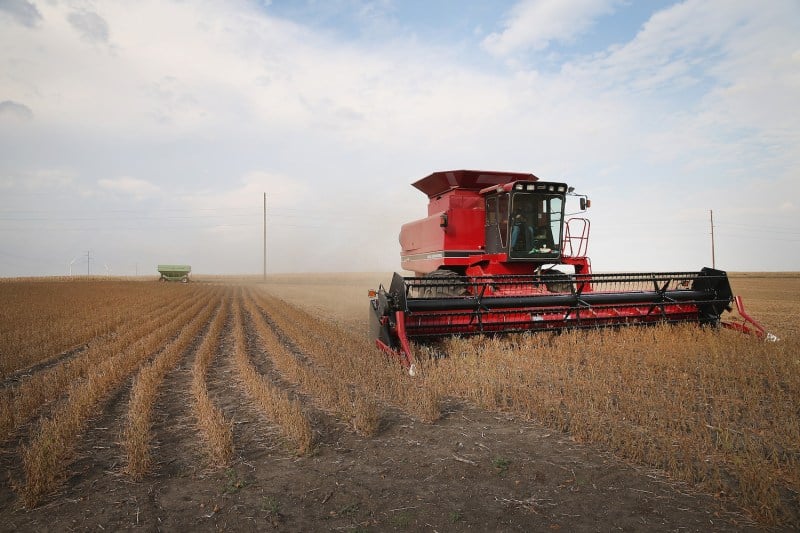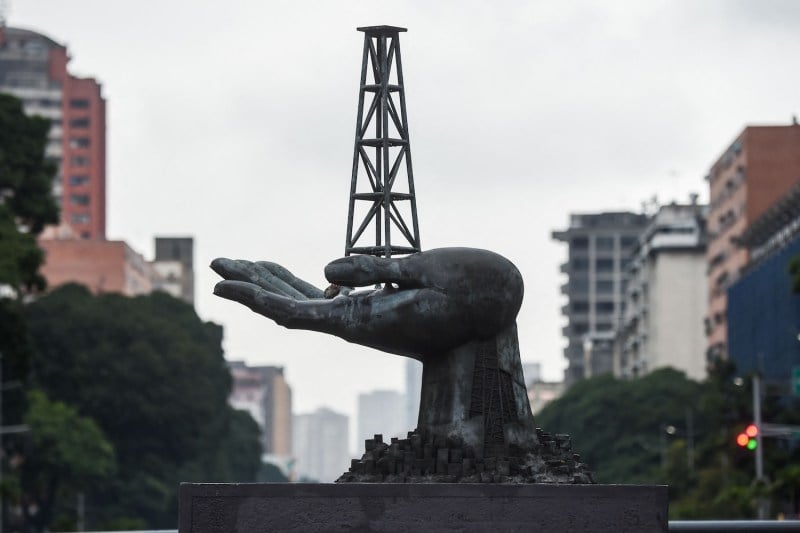American Farmers Brace for Trade War Pain

American Farmers Brace for Trade War Pain
The U.S. agricultural sector remains highly vulnerable to retaliation.
Greg Porth harvests soybeans on October 2, 2013 near Worthington, Minnesota. Scott Olson/Getty Images
As Washington’s top trading partners mull retaliatory measures against U.S. President Donald Trump’s expanding and increasingly aggressive trade war, American farmers are all but certain to be caught in the middle.
On April 2, Trump unveiled the harshest U.S. tariffs in nearly a century on friends and foes alike. It was a stunning move that upended markets and sent shockwaves through the more than 180 countries and territories targeted. Starting on April 5, the White House will impose tariffs on much of the world, ranging from 10 percent to as much as 50 percent, with some of the steepest measures concentrated in Asia. China, for example, will now face an additional 34 percent tariff, effectively boosting the value of total average U.S. tariffs on the country to more than 70 percent.
As Washington’s top trading partners mull retaliatory measures against U.S. President Donald Trump’s expanding and increasingly aggressive trade war, American farmers are all but certain to be caught in the middle.
On April 2, Trump unveiled the harshest U.S. tariffs in nearly a century on friends and foes alike. It was a stunning move that upended markets and sent shockwaves through the more than 180 countries and territories targeted. Starting on April 5, the White House will impose tariffs on much of the world, ranging from 10 percent to as much as 50 percent, with some of the steepest measures concentrated in Asia. China, for example, will now face an additional 34 percent tariff, effectively boosting the value of total average U.S. tariffs on the country to more than 70 percent.
One of the big questions now looming is whether Washington’s top trading partners will target the U.S. agricultural sector when they strike back. Much of the concern revolves around Beijing, which is one of the world’s biggest importers of agricultural goods; in 2023, it was the top market for U.S. agricultural exports, according to the U.S. Department of Agriculture.
“The real issue now will be how do countries like China respond, and some of the really big markets for agricultural commodities,” said Joseph Glauber, a former chief economist at the USDA who is now at the International Food Policy Research Institute.
China didn’t wait long to retaliate. Many of the U.S. agricultural sector’s worst fears were confirmed on April 4, when Beijing announced that it would match Trump’s policy with its own 34 percent tariffs on all imports from the United States—measures that will deal a crushing blow to American farmers.
“This practice of the US is not in line with international trade rules, seriously undermines China’s legitimate rights and interests, and is a typical unilateral bullying practice,” the Chinese Finance Ministry said in a statement.
And others may soon follow. Even before Trump’s April 2 announcement, key trading partners were retaliating against Trump’s trade policy by targeting the U.S. agricultural sector—potentially laying the groundwork for a sharper response now. The European Union, China, and Canada all fired back against his earlier measures by imposing levies on U.S. agricultural products, with Beijing in particular unveiling 10 to 15 percent tariffs on wheat, chicken, soybeans, corn, pork, and beef.
American farmers, who overwhelmingly backed Trump in the recent U.S. presidential election, have been through this before. During Trump’s first term in office, his trade war with China cost the sector more than $27 billion in lost agricultural exports between 2018 and 2019 and pushed longtime buyers to seek alternative suppliers, such as Brazil. The fallout was so painful that the first Trump administration ultimately shelled out a $28 billion bailout to farmers to help cushion the blow.
But Trump’s latest round of tariffs, which are bigger in scale and scope than before, risk injecting even more pain into the U.S. agricultural sector.
“One thing is certain: American family farmers and ranchers will bear the brunt of this global trade war,” Rob Larew, president of National Farmers Union, said in a statement. “The economic strain and uncertainty that farmers face have reached a breaking point.”
Those sentiments were echoed by Zippy Duvall, president of the American Farm Bureau Federation—the country’s largest general farm organization—who warned in a statement that “increased tariffs threaten the economic sustainability of farmers who have lost money on most major crops for the past three years.”
“Tariffs will drive up the cost of critical supplies, and retaliatory tariffs will make American-grown products more expensive globally,” said Duvall, who noted that exports contribute to more than 20 percent of farm income. “The combination not only threatens farmers’ competitiveness in the short term, but it may cause long-term damage by leading to losses in market share.”
And it’s not just Trump’s most recent announcement or the looming retaliatory tariffs that spell trouble for farmers. Another key problem is the chaotic nature of Trump’s on-again, off-again threats, which has complicated farmers’ efforts to plan for the future, experts said.
“It’s hard to think about long-term investment and management decisions when you have this much uncertainty,” said Christopher Wolf, an agricultural economist at Cornell University.
Trump has insisted that agricultural imports harm farmers, although he has said that there “may be a little bit of an adjustment period” and urged farmers to “bear with me.” But ahead of his announcement, some Republican senators were already warning that the president’s penchant for tariffs could harm the already vulnerable agricultural sector.
“Anyone who says there may be a little bit of pain before we get things right needs to talk to my farmers, who are one crop away from bankruptcy,” Sen. Thom Tillis recently told CNN.
“They don’t have time, so we’ve got to be crisp on this implementation,” he added. “Otherwise, we could do damage that is irreparable to farmers.”
Trump is reportedly now mulling a new round of emergency aid for farmers, according to the New York Times.
But even if Washington does throw farmers another financial lifeline, there would likely still be lasting damage to the industry. After Trump’s last trade war, the U.S. agricultural sector lost considerable market share in soybean sales to Brazil, which reverberates to this day.
“There are long-run costs, and if countries really move away from the United States in a big way, I think that really can be a real danger to the sector,” Glauber said.
Christina Lu is an energy and environment reporter at Foreign Policy. X: @christinafei
More from Foreign Policy
-

An illustration shows a golden Cybertruck blasting through a U.S. seal of an eagle holding arrows and laurel. Is America a Kleptocracy?
Here’s how life could change for the rich, poor, and everyone in between.
-

The flag of the United States in New York City on Sept. 18, 2019. America Is Listing in a Gathering Storm
Alarms are clanging at the U.S. geographic military commands around the globe.
-

U.S. President Donald Trump shakes hands with Supreme Court Chief Justice John Roberts during Trump’s inauguration in Washington, D.C. The U.S. Judicial Crisis Is Uniquely Dangerous
But other democracies provide a roadmap for courts to prevail over attacks from the executive branch.
-

An illustration shows a golden Newtons cradle with Elon Musk depicted on the one at left and sending a globe-motif ball swinging at right. Elon Musk’s First Principles
The world’s richest man wants to apply the rules of physics to politics. What could go wrong?










Join the Conversation
Commenting on this and other recent articles is just one benefit of a Foreign Policy subscription.
Already a subscriber?
.
Subscribe
Subscribe
View Comments
Join the Conversation
Join the conversation on this and other recent Foreign Policy articles when you subscribe now.
Subscribe
Subscribe
Not your account?
View Comments
Join the Conversation
Please follow our comment guidelines, stay on topic, and be civil, courteous, and respectful of others’ beliefs.
Change your username |
Log out
Change your username:
CANCEL
Confirm your username to get started.
The default username below has been generated using the first name and last initial on your FP subscriber account. Usernames may be updated at any time and must not contain inappropriate or offensive language.